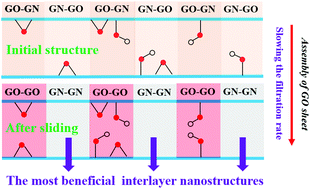Self-assembly of graphene oxide sheets: the key step toward highly efficient desalination†
Abstract
Lamellar graphene oxide (GO) membranes are new membrane materials for seawater desalination due to their selective sub-nanometer interlayer two-dimensional channels. In general, the reliable and precise desalination of GO membranes is still heavily dependent on thick membranes that usually have a low water flux. The trade-off between the water flux and ion rejection is a long-lasting problem that restricts the development of highly efficient desalination membranes. In this work, we theoretically predicted that this trade-off can be broken by the self-assembly of GO sheets during the membrane preparation. Our molecular dynamics (MD) simulations indicate that the high-water permeability of the GO membrane is due to the frictionless flow of water in the 2D nanochannels enclosed by the non-oxidized regions of neighboring GO sheets, while the oxidized regions are responsible for the high ion rejection rate. Meanwhile, the MD simulations of the self-assembly processes of GO sheets in aqueous solutions just demonstrate that the oxidized regions of neighboring GO sheets are prone to stacking with each other, while the non-oxidized regions of neighboring GO sheets are inclined to matching with each other. Therefore, more interlayer nanochannels for fast water flow and ion rejection will be formed, respectively, after the full assembly of GO sheets during membrane preparation. Finally, based on our results, a new but simple method has been proposed to prepare GO membranes with superior desalination performance via deposition rate control.



 Please wait while we load your content...
Please wait while we load your content...